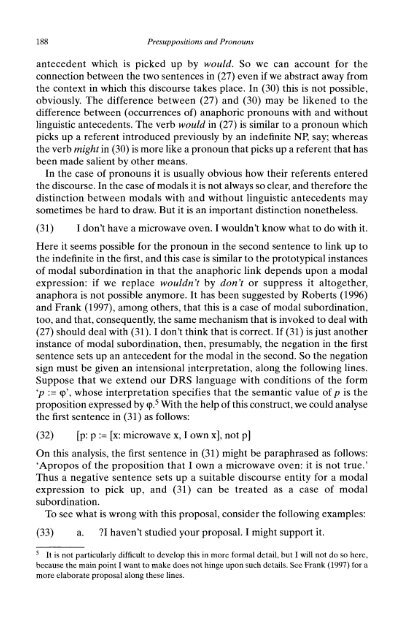Presuppositions and Pronouns - Nijmegen Centre for Semantics
Presuppositions and Pronouns - Nijmegen Centre for Semantics
Presuppositions and Pronouns - Nijmegen Centre for Semantics
You also want an ePaper? Increase the reach of your titles
YUMPU automatically turns print PDFs into web optimized ePapers that Google loves.
188 <strong>Presuppositions</strong> <strong>and</strong> <strong>Pronouns</strong><br />
antecedent which is picked up by would. So we can account <strong>for</strong> the<br />
connection between the two sentences in (27) even if we abstract away from<br />
the context in which this discourse takes place. In (30) this is not possible,<br />
obviously. The difference between (27) <strong>and</strong> (30) may be likened to the<br />
difference between (occurrences of) anaphoric pronouns with <strong>and</strong> without<br />
linguistic antecedents. The verb would in (27) is similar to a pronoun which<br />
picks up a referent introduced previously by an indefinite NP, Np, say; whereas<br />
the verb might in (30) is more like a pronoun that picks up a referent that has<br />
been made salient by other means.<br />
In the case of pronouns it is usually obvious how their referents entered<br />
the discourse. In the case of modals it is not always so clear, <strong>and</strong> there<strong>for</strong>e the<br />
distinction between modals with <strong>and</strong> without linguistic antecedents may<br />
sometimes be hard to draw. But it is an important distinction nonetheless.<br />
(31) I don't have a microwave oven. I wouldn't know what to do with it.<br />
Here it seems possible <strong>for</strong> the pronoun in the second sentence to link up to<br />
the indefinite in the first, <strong>and</strong> this case is similar to the prototypical instances<br />
of modal subordination in that the anaphoric link depends upon a modal<br />
expression: if we replace wouldn't by don't or suppress it altogether,<br />
anaphora is not possible anymore. It has been suggested by Roberts (1996)<br />
<strong>and</strong> Frank (1997), among others, that this is a case of modal subordination,<br />
too, <strong>and</strong> that, consequently, the same mechanism that is invoked to deal with<br />
(27) should deal with (31). I don't think that is correct. If (31) is just another<br />
instance of modal subordination, then, presumably, the negation in the first<br />
sentence sets up an antecedent <strong>for</strong> the modal in the second. So the negation<br />
sign must be given an intensional interpretation, along the following lines.<br />
Suppose that we extend our DRS language with conditions of the <strong>for</strong>m<br />
'p '/ := (p',














